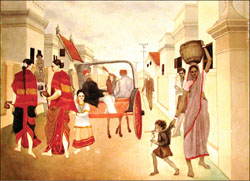by Girija Madhavan
Mysuru has a tradition of holding concerts for festive occasions like Ramanavami and Vinayaka Chathurthi. Lovers of music eagerly look forward to these events. The concerts held at 8th Cross in Vani Vilasa Mohalla have been going on for decades. Even earlier there were recitals in Bidaram Krishnappa Prasanna Sri Rama Mandira in the heart of the city. A temple as well as a venue for “kacheris,” it is the confluence of two streams of art. As music swirls around the room, the walls display precious paintings in elaborately carved frames. Some of them are in the Mysore tradition of art, depicting themes like Durga’s victory or Rama’s coronation. Some are adorned with gold leaf and some are in the style of Raja Ravi Varma.
In a folder of sketches by my mother, Mukta Venkatesh, I found two water-colours. The first depicts a Karnatak concert (kacheri) with the musicians seated on a striped durrie. The small picture hanging above the door is the ‘Ala-ele Krishna’ (the infant Krishna on a peepul leaf), a theme favoured by both Tanjore and Mysore style artists. The paintings of Goddesses Lakshmi and Saraswati in traditional style flank a larger picture of Rama Pattabhisheka. Mukta depicts herself and two sisters in the audience. This is a sketch of Bidaram Krishnappa Prasanna Sitarama Mandira, a personal portrayal of a heritage landmark of Mysuru.
The second picture is set in Lakshmipuram of those days. The architecture is drawn with care. The people on the street belong to different classes of society. The vendor woman, accompanied by her small child, is dressed in a crumpled cotton sari, the head covered with the end of the sari or “seragu.” In contrast, the ladies in silk saris worn in the “kachche” style (perhaps of Madhwa origin), flowers adorning their hair, have returned from a puja, holding coconuts and betel leaves in their hands.
Just beyond these figures is a mendicant with a white beard. A toddler rides on his shoulders. This poor man and his child “Vasuki” occasionally visited my mother, had a meal and left with a present of money, clothes or toys. She was attached to Vasuki and was distressed when the visits suddenly stopped. Perhaps that is why she painted them as pale, ghostly figures.
In the Tonga, a dignified, Muslim gentleman travels to his appointment. Another older man in a three-piece suit wearing a Mysore Peta is walking down the pavement. A young man lounges against the wall. This picture was a microcosm of life in suburbia.
Old photographs capture past reality in their sepia tints. But drawings like these can be even more evocative, bringing up a flavour of a bygone time through the eyes of a person who lived then and translated these perceptions into art.
source: http://www.starofmysore.com / Star of Mysore / Home> Feature Articles / Monday – October 12th, 2015
